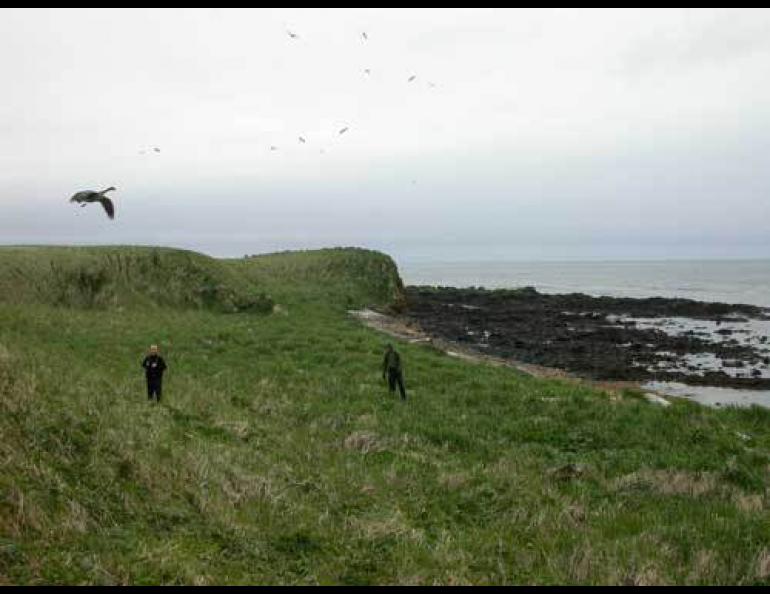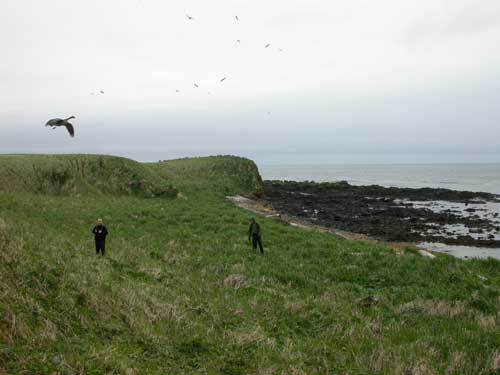
Arctic foxes made Aleutians less green
The Aleutians would probably be a lot greener if it weren’t for the arctic foxes people planted on them, researchers have found.
In a study published in Science magazine in March 2005, scientists from California, Montana and Alaska compared islands with and without foxes in the Aleutians. They discovered that islands with foxes are covered mostly with tundra, while fox-free islands have patches of lush grasslands. The major difference in types of greenery could be the lack of seabirds on islands with foxes, coupled with the fertilizing power of the birds’ guano on fox-free islands.
Foxes and their fur became a cash crop in the Aleutians after sea otters disappeared due to overhunting in the 1800s. Russians and later American fur traders would drop as few as a pair of arctic foxes on islands and that pair would multiply to a trappable population within a few years. By 1936, at least 190 islands in the Aleutians had imported foxes living on them, according to Edgar Bailey of the U.S. Fish and Wildlife Service, who wrote a report on the subject in 1993.
Arctic foxes wiped out birds that nest on the ground, such as Aleutian geese, and those that nest in burrows, including puffins. The lack of birds caused many of the islands to become silent and plants lost a major source of fertilizer.
Vernon Byrd came up with the idea for the vegetation study a few decades ago, while monitoring cleanup of Amchitka for the U.S. Fish and Wildlife Service following the underground detonation of three nuclear bombs there. Now a senior biologist with the Alaska Maritime National Wildlife Refuge in Homer, Byrd in 1972 noticed round green spots on the island where fertilizer had leaked from bags. From that, he reckoned that Amchitka, which had foxes for decades, was a nutrient-starved place. He lived on Adak Island at the time—another island with foxes—and saw that plants there grew large and green at sites where hunters had left caribou bones and gut piles.
In the 1980s, when Byrd and others were looking for potential nesting habitat for the then-endangered Aleutian goose, Byrd saw that short tundra plants dominated most of the islands. The few islands that had no foxes, such as Buldir Island, were thick with rye grass, celery, and cow parsnip.
Speaking with longtime Aleutians sea-otter biologist Jim Estes of the University of California Santa-Cruz, Byrd proposed a study on how foxes may have affected the islands’ plant makeup. Estes recruited fellow researchers Don Croll and John Moran to set up a study that became the basis for the Science article. They compared nine fox-free islands to nine with foxes and found that breeding seabird densities were much higher on the islands without foxes. They found one 2,000-acre island without foxes had a breeding seabird population of 1.7 million; a similar island with foxes had 7,000. Fewer birds on islands with foxes meant an annual decline in the amount of guano from 361.9 grams per square meter to 5.7 grams per square meter. The scientists wrote that the total soil phosphorus on fox-free islands was three times that on islands with foxes. They also found more insects on the islands without foxes.
Since 1949, biologists and trappers have removed foxes from more than 37 Aleutian Islands. Populations of seabirds have exploded on many of those islands, which also are becoming greener. Time will tell if the islands return to how they looked at the time of the first fox transplant, by a Russian sailor on Alaska’s farthest west island, Attu, in 1750.
“Ecosystem recovery is definitely underway on many islands as breeding colonies of gulls, tufted puffins, and other species reoccupy former nesting areas following fox removal,” Byrd wrote in an email message. “It will be very interesting to see what the islands look like in 100 years.”





